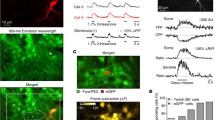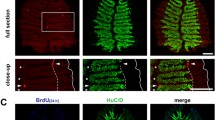Summary
The factors controlling neurogenesis and differentiation of olfactory receptor cells in adults are poorly understood, although it is often stated that these cells undergo continual turnover after a pre-determined lifespan. An interesting model in which to study mechanisms which control olfactory receptor neurogenesis and cell turnover is the tiger salamander, since basal cell mitosis varies with epithelial thickness and location in the nasal cavity. This paper presents a quantitative light-microscopic study of the different cell types within the ventral olfactory epithelium of the tiger salamander using a computer-assisted morphometric analysis of 2 μm sections. The results show that the surface density of olfactory vesicles remained constant throughout most of the epithelium and was independent of nasal cavity location, epithelial thickness and the total number of nuclei per unit epithelial surface area. Histological classification of nuclei into different cell types indicated that the increase in total cell number with epithelial thickness was mainly due to an increase in the number of immature receptor cells since the number of supporting cells varied only slightly and the numbers of basal cells and mature receptor cells remained constant except in the thinnest, most caudally located epithelium. It is concluded that the rate of maturation of receptor cells may be limited by an optimal surface density of olfactory vesicles. That is, when this density reaches 4.5×104 vesicles per mm2 there is a physical or chemical mechanism which prevents the final maturation of newly developing receptor cells, leading to their accumulation. This mechanism may also account for the variations in basal cell mitosis in this species.
Similar content being viewed by others
References
Abercrombie M (1946) Estimation of nuclear population from microtome sections. Anat Rec 94: 274–329
Allison AC (1953) The morphology of the olfactory system in vertebrates. Biol Rev 28: 195–244
Allison AC, Warwick RTT (1949) Quantitative observations on the olfactory system of the rabbit. Brain 72: 187–197
Breipohl W, Grandt D, Rehn B, Mackay-Sim A, Hierche H (1985a) Investigations of cell replacement in the olfactory epithelium. Neurosci Lett Suppl 19: S7
Breipohl W, Laugwitz HJ, Bornfeld N (1974) Topological relations between the dendrites of olfactory sensory cells and sustentacular cells in different vertebrates. J Anat 117: 89–94
Breipohl W, Mackay-Sim A, Grandt D, Rehn B, Darrelmann C (1986) Neurogenesis in the vertebrate main olfactory epithelium. In: Breipohl W (ed) Ontogeny of olfaction. Springer, New York, pp 21–34
Breipohl W, Mestres P, Meller K (1973) Lichtund elektronmikroskopische Befunde zur Differenzierung des Riechepithels der weißen Maus. Verh Anat Ges 67: 443–449
Breipohl W, Moulton DG, Ummels M, Matulionis D (1982) Spatial pattern of sensory cell terminals in the olfactory sac of the tiger salamander. I. A scanning electron microscope study. J Anat 134: 757–769
Breipohl W, Rehn B, Molyneux GS, Grandt D (1985b) Plasticity of neuronal cell replacement in the main olfactory epithelium of mouse. Proc XII Int Anat Congr London
Clark WE, Le Gros, Warwick RTT (1956) The pattern of olfactory innervation. J Neurol Neurosurg Psychiat 36: 33–45
Dixon WJ, Brown MB (1979) BMDP Biomedical Computer Programs P-series. University of California Press, Berkeley
Gasser HS (1956) Olfactory nerve fibres. J Gen Physiol 39: 473–498
Getchell TV (1973) Analysis of unitary spikes recorded extracellularly from frog olfactory receptor cells and axons. J Physiol 234: 533–551
Graziadei PPC, Metcalf JF (1971) Autoradiographic and ultrastructural observations on the frog's olfactory mucosa. Z Zellforsch 116: 305–318
Graziadei PPC, Monti Graziadei GA (1976) Olfactory epithelium of Necturus maculosus and Ambystoma tigrinum. J Neurocytol 5: 11–32
Graziadei PPC, Monti Graziadei GA (1978) Continuous nerve cell renewal in the olfactory system. In: Jacobson M (ed) Development of sensory systems. Springer, Berlin, pp 55–84
Graziadei PPC, Monti Graziadei GA (1979) Neurogenesis and neuron regeneration in the olfactory system of mammals. I. Morphological aspects of differentiation and structural organization of the olfactory sensory neurons. J Neurocytol 8: 1–18
Halasz P, Martin PR (1984) A microcomputer based system for semiautomatic analysis of histological sections. Proc R Microscop Soc 19: 312P
Hendry IA (1976) A method to correct adequately for the change in neuronal size when estimating neuronal numbers after nerve growth factor treatment. J Neurocytol 5: 337–349
Hinds JW, McNelly NA (1981) Aging in the rat olfactory system: correlation of changes in the olfactory epithelium and olfactory bulb. J Comp Neurol 203: 441–453
Hinds JW, Hinds PL, McNelly NA (1984) An autoradiographic study of the mouse olfactory epithelium: evidence for long- lived receptors. Anat Rec 210: 375–383
Kerjaschki D, Hörandner H (1976) The development of mouse olfactory vesicles and their cell contacts: a freeze etching study. J Ultrastruct Res 54: 420–444
Kubie J, Mackay-Sim A, Moulton DG (1980) Inherent spatial patterning of responses to odorants in the salamander olfactory epithelium. In: van der Starre H (ed) Olfaction and taste, Vol VII. IRL Press, London, pp 163–166
Mackay-Sim A, Beard MD (1987) Hypothyroidism disrupts neural development in the olfactory epithelium of adult mice. Dev Brain Res 36: 190–198
Mackay-Sim A, Kubie JL (1981) The salamander nose: a model system for the study of spatial coding of olfactory quality. Chem Senses 6: 249–257
Mackay-Sim A, Nathan MH (1984) The projection from the olfactory epithelium to the olfactory bulb in the salamander, Ambystoma tigrinum. Anat Embryol 170: 93–97
Mackay-Sim A, Patel U (1984) Regional differences in cell density and cell genesis in the olfactory epithelium of the salamander, Ambystoma tigrinum. Exp Brain Res 57: 99–106
Mackay-Sim A, Shaman P (1984) Topographic coding of odorant quality is maintained at different concentrations in the salamander olfactory epithelium. Brain Res 297: 207–217
Mackay-Sim A, Shaman P, Moulton DG (1982) Topographic coding of olfactory quality: patterns of epithelial responsivity in the salamander. J Neurophysiol 48: 584–596
Menco BPM (1980) Qualitative and quantitative freeze-fracture studies on olfactory and nasal respiratory structures of frog, ox, rat and dog. I. A general survey. Cell Tiss Res 207: 183–209
Menco BPM (1983) The ultrastructure of olfactory and nasal respiratory epithelium surfaces. In: Reznik G, Stinson SF (eds) Nasal tumors in animals and man, Vol 1. Anatomy, physiology and epidemiology. CRC Press, Boca Raton Florida, pp 45–102
Menco BPM, Leunisson JLM, Bannister LH, Dodd GH (1978) Bovine olfactory and nasal epithelium surfaces. Cell Tiss Res 193: 503–524
Moulton DG (1975) Cell renewal in the olfactory epithelium of the mouse. In: Denton DA, Coughlan JP (eds) Olfaction and taste Vol V. Academic Press, New York, pp 111–114
Moulton DG, Celebi G, Fink RP (1970) Olfaction in mammals — two aspects: proliferation of cells in the olfactory epithelium and sensitivity to odours. In: Wolstenholme GEW, Knight J (eds) Taste and smell in vertebrates. Churchill, London, pp 227–250
Nathan MH, Moulton DG (1981) 2-deoxyglucose analysis of odorant-related activity in the salamander olfactory epithelium. Chem Senses 6: 259–266
Weibel ER (1980) Stereological methods, Vol 2. Theoretical foundations. Academic Press, London
Author information
Authors and Affiliations
Rights and permissions
About this article
Cite this article
Mackay-Sim, A., Breipohl, W. & Kremer, M. Cell dynamics in the olfactory epithelium of the tiger salamander: a morphometric analysis. Exp Brain Res 71, 189–198 (1988). https://doi.org/10.1007/BF00247534
Received:
Accepted:
Issue Date:
DOI: https://doi.org/10.1007/BF00247534




